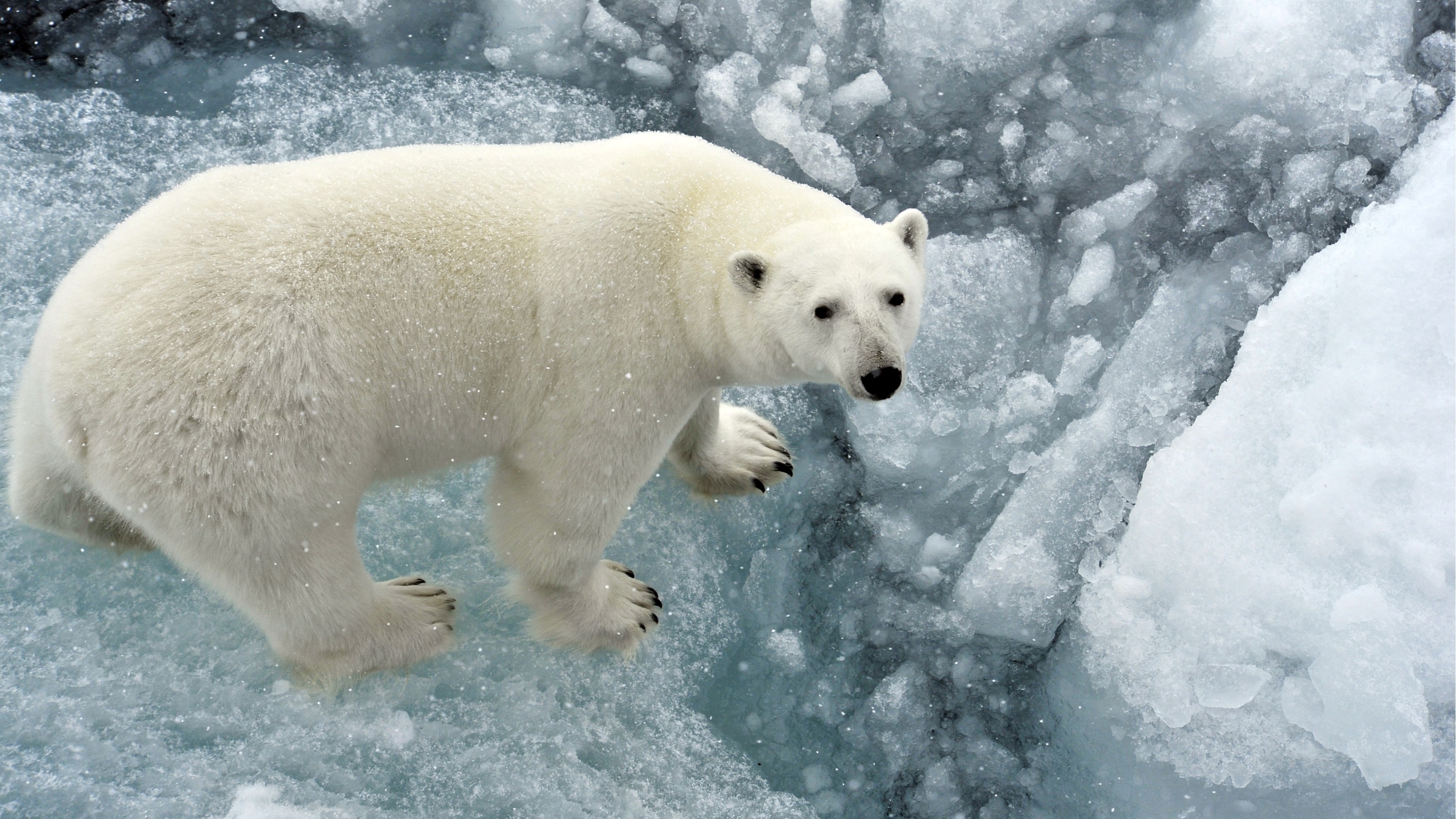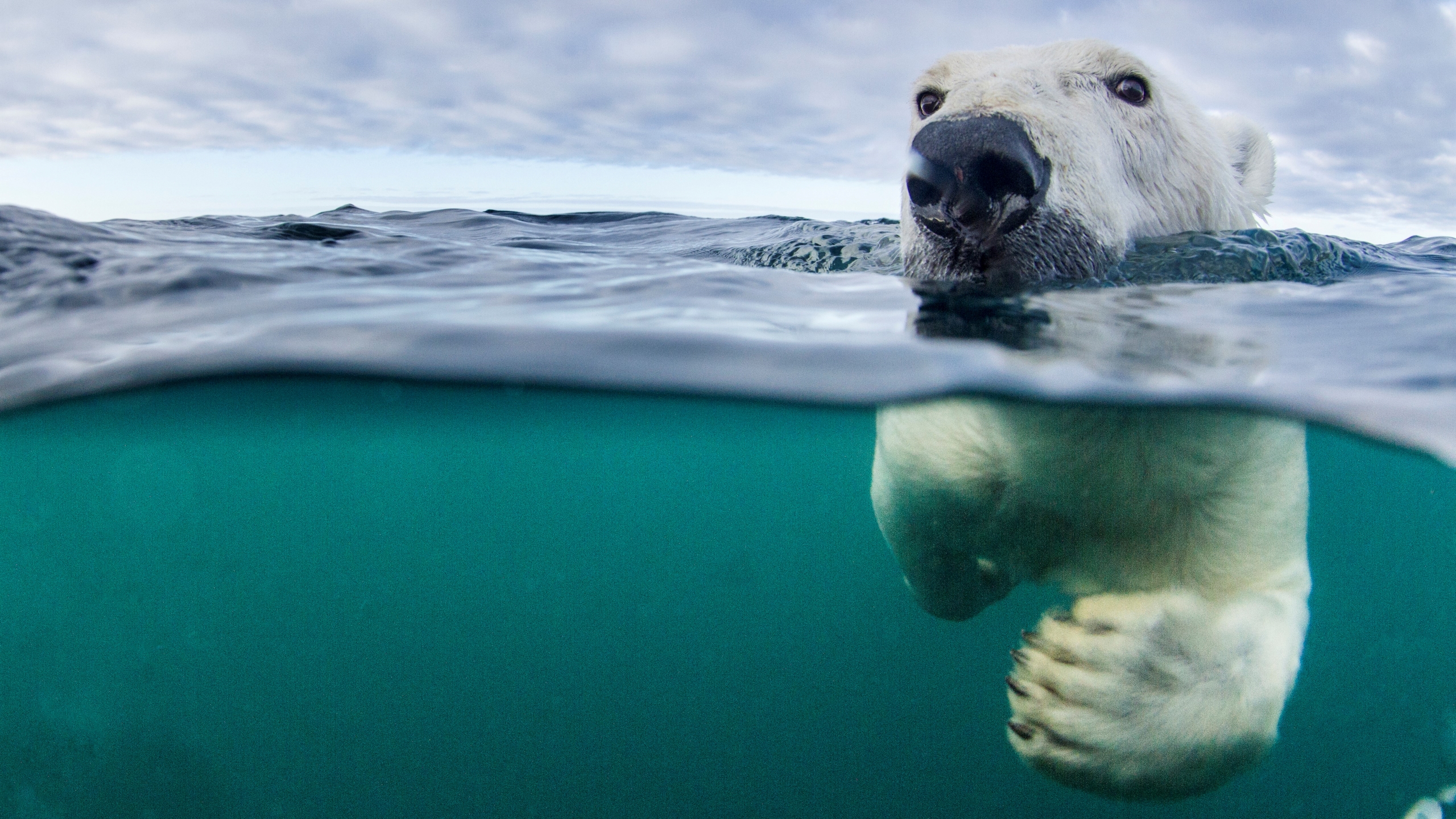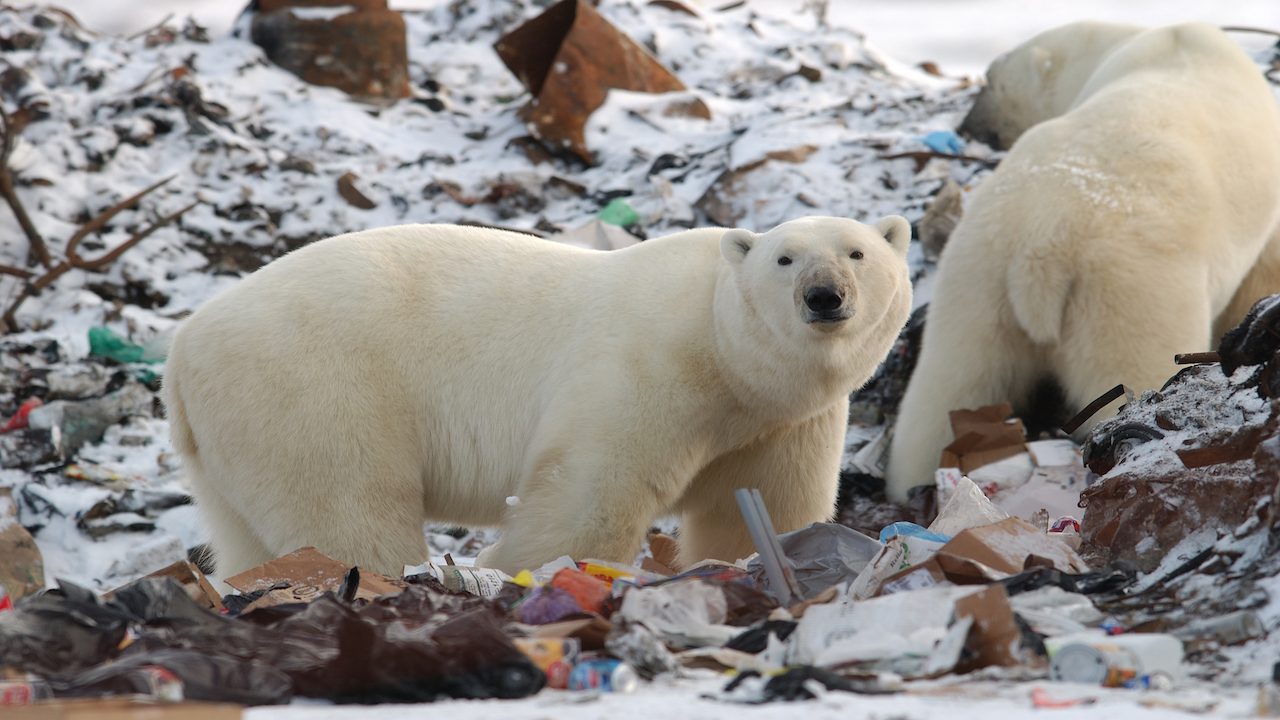Polar bears: The largest land carnivores
Polar bears are classed as marine mammals.
Polar bears (Ursus maritimus) are the largest bear species and the biggest land carnivores in the world. The enormous bears live in the Arctic, where they prowl the icy expanse searching for seals, their preferred prey.
Polar bears likely evolved within the last 500,000 years when a population of brown bears traveled north into the Arctic during a warm period and became isolated. When temperatures dropped again, the bears were forced to adapt to the colder environment, according to Aarhus University's Arctic Research Centre in Denmark.
Polar bears have many adaptations for life in the frigid Arctic, including dense fur and a thick layer of fat to keep them warm, as well as small bumps under their paws to stop them from slipping on the ice, according to Polar Bears International. They are excellent swimmers, and their scientific name, Ursus maritimus, translates to "sea bear," according to the San Diego Zoo. Polar bears depend heavily on the ocean environment and are the only bears to be considered marine mammals.
Related: Polar bear photos: Stunning shots capture Earth's icons of climate change
Size & appearance
Polar bears are usually 3.5 to 5 feet (1 to 1.5 meters) tall at the shoulder on all fours, but an adult male may reach more than 10 feet (3 m) when standing on its hind legs, according to Polar Bears International. In 1960, a polar bear that was killed in Alaska stood 12 feet (3.7 m) tall on its hind legs, according to the National Wildlife Federation.
Male polar bears usually weigh between 770 pounds and more than 1,300 pounds (350 to 600 kilograms). The 12-foot-tall Alaskan bear shot in 1960 is the heaviest recorded bear and weighed 2,210 pounds (1,000 kg). Females weigh half as much as their male counterparts, at 330 to 650 pounds (150 to 295 kg), according to Polar Bears International.
Size: 3.5 to 5 feet (1.5 m) tall at the shoulder (all fours)
Life span: 15 to 18 years
Conservation status: Vulnerable
Polar bear fur appears to be white but it's actually transparent; the white appearance is due to visible light scattering and reflecting back off clear, hollow strands of hair, according to Polar Bears International. Their white appearance enables the bears to blend in with their snow-covered, icy environment. Polar bears can also appear yellowish or even brown and gray, depending on the season and light conditions. Polar bear skin is black and absorbs the heat of the sun, which helps keep the bears warm.
Get the world’s most fascinating discoveries delivered straight to your inbox.
Polar bears vs. Kodiak bears
Polar bears are the biggest bear species, but Kodiak bears, a subspecies, or type of brown bear, can grow to about the same size as some polar bears. Kodiak bears live on islands in the Kodiak Archipelago off southern Alaska, where they have been isolated from other brown bears for about 12,000 years, according to the Alaska Department of Fish and Game. These brown bears can stand over 10 feet (3m) tall on their hind legs and weigh up to 1,500 pounds (680 kg), according to the Alaska Department of Fish and Game.
Some sources, such as the Alaska Department of Fish and Game, claim that Kodiak bears are the largest bears on Earth. The confusion is partly due to the way that "largest" is defined, because the answer varies depending on whether bears are measured by length, weight, or by the largest individual ever recorded, according to the Library of Congress in Washington, D.C. Polar bears are heavier and taller on average, but individual Kodiak bears may be larger than average-size polar bears.
Where do polar bears live?
Polar bears live on the ice-covered waters of the Arctic and countries around the Arctic Circle, including Canada, Alaska in the U.S., Greenland (part of Denmark), Norway, Russia and occasionally Iceland, according to the International Union for Conservation of Nature (IUCN). They are not found in Antarctica, where penguins live.
Some polar bears stay on permanently frozen sea ice in the Arctic Basin, but most live on the annual sea ice that forms around the Arctic Basin. This annual sea ice melts in the summer, so polar bears are forced to spend several months on land while they wait for it to freeze over again, according to the IUCN.
Polar bears swim between sea ice and the shore, hunting down prey, searching for mates, or just cooling off. They paddle through the water with their big front paws and use their back legs as rudders, according to Sea World. They also have webbing between their toes, similar to ducks' feet, which helps them swim.
Polar bears have been recorded swimming for nearly 10 days at a time and traveling up to 427 miles (687 kilometers) in a single swim without stopping to rest, Live Science previously reported. Long swims like this put polar bears at risk of drowning, but they may be forced to undertake such great journeys more often as warming temperatures associated with climate change melt sea ice in the Arctic.
Related: Sweating the details: Polar bear hits the treadmill for science
What do polar bears eat?
Polar bears are the most carnivorous bear species and almost exclusively eat meat. Their primary prey are ringed seals (Pusa hispida), according to the National Wildlife Federation. Polar bears will sit by a seal breathing hole waiting for a seal to pop up so they can grab it. The bears will also sniff out seal dens, then crash through the roof and kill the seals inside.
If polar bears have a plentiful supply of seals and are in good health, they'll only eat the seal's blubber, according to Polar Bears International. This is the highest calorie meal available to polar bears and helps them build up fat reserves and stay healthy between feedings. Polar bears can consume 4.4 pounds (2 kg) of fat each day, according to the World Wildlife Fund (WWF).
Polar bears will also hunt walruses, sea birds, fish and small mammals such as rodents; scavenge on whale carcasses and other dead animals; and eat small amounts of vegetation, according to the University of Michigan's Animal Diversity Web (ADW). However, these are alternative food sources when seals aren't plentiful; seals are crucial to sustaining a polar bear population. Polar bears are top of the food chain and have no natural predators other than humans.
Related: Polar bears now eat dolphins, thanks to global warming
Life in the cold
Polar bears are solitary except for when a mother is raising her cubs. However, unrelated bears will occasionally be seen together, such as when they share a large whale carcass or garbage dump, or when they are waiting on land for sea ice to re-form, according to Sea World. They do not defend territories, but polar bears may occasionally fight over a carcass, and males may fight over a female during the breeding season, between March and June.
Male polar bears find females by following their scent, and the pair may spend a week or more with each other. After mating, fertilized eggs don't enter the female's uterus straight away, and this process is delayed until usually September or November, according to the San Diego Zoo. Polar bears have a gestation period of up to about seven months including this delayed implantation. Pregnant females will dig a cave in a snowbank to give birth in; called a maternity den. Polar bears do not hibernate in winter, unlike most brown bears and black bears, and will continue to hunt unless the weather is extremely harsh.
Kingdom: Animalia
Phylum: Chordata
Class: Mammalia
Order: Carnivora
Family: Ursidae
Genus & species: Ursus maritimus
Source: ITIS
A female polar bear gives birth in her den, typically to twins in December or January. Newborn polar bear cubs usually weigh just 1.3 pounds (0.6 kg), according to the San Diego Zoo. The cubs grow quickly on their mother's milk and will start exploring outside their den by spring, although they don't travel far for the first 12 days or more and still sleep inside the den at night, according to Sea World. Polar bear cubs stay with their mother for up to three years learning how to survive. Wild polar bears usually live for 15 to 18 years but can survive into their 30s, according to Polar Bears International. A captive polar bear called Debby lived to be 42 years old in Assiniboine Park Zoo in Canada. She was believed to be the world’s oldest polar bear when she died in 2008, according to Reuters.
Related: Polar bear body cam shows predator's POV
Are polar bears dangerous to humans?
Polar bears rarely attack humans. A 2017 study published in the journal Wildlife Society Bulletin cataloged 73 confirmed polar bear attacks between 1870 and 2014, including 20 fatalities. The researchers found that nutritionally stressed male bears were most likely to attack humans and that most attacks were predatory, meaning the bear was killing for food. Polar bear attacks increased over the study period, which is likely due to changes in their environment.
"The danger is the proximity to people, coupled with an increasing number of polar bears in poor body condition spending more time on shore. Both people and bears are trying to adapt to rapid changes on the ground and at sea," Geoff York, study co-author and senior director of conservation at Polar Bears International, said in a statement at the time. As sea ice declines and moves further from the shore, more polar bears spend longer periods on land, such as in Hudson Bay in northeastern Canada.
"Bears are now having to make a choice as the ice melts each year: Do they stay on the ice and retreat with it into deep Arctic waters or do they jump, come to shore, and take their chances on land?" York said. "Those who come ashore may come into conflict with human communities or activities. And as they get more desperate for food, they may well take higher risks."
Related: 52 polar bears 'invade' a Russian town to eat garbage instead of starve to death
Are polar bears endangered?
Polar bears are vulnerable to extinction, according to the IUCN Red List of Threatened Species. Climate change poses the biggest threat to their long-term survival as increasing temperatures cause the Arctic sea ice they depend on to shrink. They are also threatened by other human-related activities, such as oil and gas drilling in the Arctic, which increases the risk of negative human-bear interactions.
There are only about 26,000 polar bears living in the wild, according to the IUCN. However, estimating the number of polar bears is difficult because they live in such remote habitats at low densities, and information about their subpopulations is often poor or outdated. Polar bears are listed on the U.S. Endangered Species List as threatened and are protected under the Marine Mammal Protection Act.
Inuit and Indigenous people still hunt polar bears for food and clothing as part of long-held cultural traditions, but this hunting is carefully regulated. The Inuit people have long believed that polar bears, which they call "Nanuq," are wise, powerful and almost human, according to Polar Bears International.
Related: 'Pizzly' bear hybrids are spreading across the Arctic thanks to climate change
Additional resources
- The United States Geological Survey carries out long-term research on polar bears
- Polar Bears International has more information about polar bears and conservation efforts to save them.
- Children's Book: "The Polar Bear" (Enchanted Lion Books, 2016).
This article was originally written by Live Science contributor Alina Bradford and has since been updated.

Patrick Pester is the trending news writer at Live Science. His work has appeared on other science websites, such as BBC Science Focus and Scientific American. Patrick retrained as a journalist after spending his early career working in zoos and wildlife conservation. He was awarded the Master's Excellence Scholarship to study at Cardiff University where he completed a master's degree in international journalism. He also has a second master's degree in biodiversity, evolution and conservation in action from Middlesex University London. When he isn't writing news, Patrick investigates the sale of human remains.






